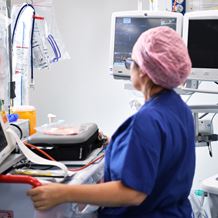
- Home
- Services
- Cardiac Services
- Procedures and Treatments
- Left Atrial Appendage Closure
What is a left atrial appendage closure?
Left atrial appendage closure is a type of preventative surgery that seals off part of your heart in order to reduce the risk of blood clotting. The left atrial appendage is shaped like a small pouch at the top of the left chamber. It is a part of your heart that doesn’t have a clear function. If you have a heart condition such as atrial fibrillation, where an irregular heart pattern means that blood is not always pumped effectively out of the heart, there is a serious risk that blood could collect in the left atrial appendage and increase the chance of a stroke. Left atrial appendage closure reduces this risk, and in many cases removes the need for blood thinners.
What does it do?
Left atrial appendage closure reduces the risk of stroke associated with heart conditions such as atrial fibrillation. If you have an irregular heartbeat, it means your heart cannot work efficiently. In some cases, it is unable to completely squeeze all the blood out of the left chamber. Any blood that remains in the left atrial appendage increases the risk of clotting. Left atrial appendage closure shuts off the pouch-shaped sac to prevent this happening, thereby reducing any associated risks. After left atrial appendage closure, you will be transferred to the ward for monitoring. Your doctor may recommend further transoesophageal echocardiograms (TOE) before you are discharged to check that the seal is well positioned. Your medical team will provide you with detailed instructions on your wound care and recovery at home.
How does it work?
Every time your heart contracts, blood is squeezed out of your left upper chamber (atrium) into the lower chamber. If you suffer from a heart condition such as atrial fibrillation, the electrical impulses that control your heartbeat don’t behave in an orderly way. This means the heart doesn’t always have time to complete the entire task, and not all the blood is squeezed out every time. The left atrial appendage is perfectly shaped for blood to collect and pool – and it is a known starting point for blood clots in patients with atrial fibrillation. Closing off the left atrial appendage has no effect on the heart function, other than to reduce any risk to health for the future.
Why is it performed?
Your doctor may recommend left atrial appendage closure if you have a heart condition that affects the regularity of your heartbeat, such as atrial fibrillation. It is also an alternative to blood thinning medication such as warfarin, which is not always suitable for every patient. In a situation where you are unable to take this type of medication, left atrial appendage closure surgery may provide a suitable alternative.
Procedure
Left atrial appendage closure can either be performed as a minimally invasive procedure or open surgery. Your doctor may firstly recommend a transoesophageal echocardiograms (TOE) to check there are no clots present in advance of surgery. A local or general anaesthetic is used to help relax you and put you to sleep. A catheter is inserted into your groin and guided up to the heart. Using an X-ray, an echocardiogram, and a special dye, a device is positioned at the opening of the left atrial appendage. This device is expanded to seal the entrance. A thin layer of tissue gradually grows over the device to keep it in place.
Recovery
After left atrial appendage closure, you will be transferred to the ward for monitoring. Your doctor may recommend further transoesophageal echocardiogram (TOE) before you are discharged to check that the seal is well positioned. Your medical team will provide you with detailed instructions on your wound care and recovery at home.
What's next?
If you have been experiencing heart-related symptoms, book an appointment with our cardiac services specialist today.
Our specialists in Cardiac Services
View all specialists





